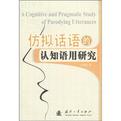仿拟话语的认知语用研究
出版时间:2008-11 出版社:国防工业出版社 作者:么孝颖 著 页数:322
内容概要
《仿拟话语的认知语用研究》运用语用学和认知语言学的理论和观点对仿拟话语进行专题研究。全书共8章,以仿拟话语认知语用模式为出发点,对仿拟话语的生成过程即发话言行和示意言行进行了系统的认知语用分析,为仿拟话语研究提供了一个崭新的视角,同时也为二语/外语的话语教学提供了新的启示,对国内外从事语言学研究的专家学者具有一定的参考价值和借鉴作用。
作者简介
么孝颖,女,博士,研究方向为认知语言学、语用学和社会语言学。现为上海电力学院直属外语系副教授。先后在外语类期刊上发表学术论文20余篇。
书籍目录
Chapter 1 Introduction1.1 The research topic1.2 A cognitive and pragmatic approach1.2.1 Linguistic outlook of cognitive linguistics1.2.2 Pragmatic outlook on language and meaning1.2.3 Common assumptions in a cognitive and pragmatic approach1.3 Methodology and data1.4 Organization of the bookChapter 2 Previous Researches on Parodying Utterances2.1 Rhetorical and pragmatic study of parody2.1.1 The basic conceptual elements in the usage of parody2.1.2 Classification of parody2.1.3 Structure and features of parody2.1.4 The pragmatic functions of parody2.1.5 The pragmatic relationship between PGUs and PDUs2.2 Text-linguistic study of parody2.2.1 Bakhtin s dialogic view of parody2.2.2 Intertextual study of parody2.3 Cognitive study of parody2.3.1 Prototype and parody2.3.2 Relevance theory and parody2.3.3 Figure/Ground theory and parody2.3.4 Mental space theory and parody2.4 SummaryChapter 3 A Cognitive and Pragmatic Framework for Parodying Utterance Study3.1 Theoretical foundations3.1.1 Speech act theory3.1.2 Symbolic thesis3.1.3 Conceptual blending theory3.2 A proposed framework for parodying utterances analysis3.2.1 Parodying utterances : speech acts3.2.2 Classifying parodying utterances3.2.3 Linguistic blending analysis of parodying utterances3.2. d A cognitive and pragmatic framework for parodying utterance analysis3.3 Specific illustrations to the framework3.3.1 Locutionary act : linguistic blending analysis of parodying utterance3.3.2 Illocutionary act : pragmatic analysis of parodying utteranceChapter 4 Parodying Utterances with Similar C-SS and GLS4.1 Linguistic blending operation4.1.1 Blending characterization of Input 14.1.2 Blending characterization of Input 24.1.3 Blending of Input 1 and Input 24.2 Blending conditions4.2.1 Similar conceptual structure4.2.2 Pragmatic appropriateness4.3 Blending principles4.3.1 Maximized motivation for similarity in C-SS and GLS4.3.2 Maximized motivation for conceptual-semantic coherence4.3.3 Maximized motivation for pragmatic coherence4.4 Features of resulting parodying utterances4.4.1 Radial and hierarchical distribution4.4.2 Structural stability4.4.3 Flexible expression4.5 Pragmatic force of resulting parodying utterances4.6 SummaryChapter 5 Parodying Utterances with Shifted C-SS and GLS5.1 Linguistic blending operation5.1.1 Blending characterization of Input 15.1.2 Blending characterization of Input 25.1.3 Blending of Input 1 and Input 25.2 Blending conditions5.2.1 A shifted frame5.2.2 The similar conceptual structure5.2.3 The same semantic field5.3 Blending principles5.3.1 Maximized motivation for similarity in C-SS and GLS5.3.2 Maximized motivation for semantic coherence5.3.3 Maximized motivation for pragmatic coherence5.4 Features of resulting parodying utterances5.4.1 Context-unique5.4.2 Structural difference5.4.3 Non-flexible expression5.5 Pragmatic force of resulting parodying utterances5.5.1 Colliding5.5.2 Uneolliding5.6 SummaryChapter 6 Parodying Utterances with Similar PS6.1 Linguistic blending operation6.1.1 Blending characterization of Input 16.1.2 Blending characterization of Input 26.1.3 Blending of Input 1 and Input 26.2 Blending conditions6.2.1 Correlated conceptual structure6.2.2 Similar phonological structure6.2.3 Pragmatic appropriateness6.3 Blending principles6.3.1 Maximized motivation for phonological similarity6.3.2 Maximized motivation for pragmatic coherence6.4 Features of resulting parodying utterances6.4.1 Radial and hierarchical distribution6.4.2 Stable phonological structure6.4.3 Flexible expression6.5 Pragmatic force of resulting parodying utterances6.5.1 Colliding6.5.2 Uneolliding6.6 SummaryChapter 7 Parodying Utterances with Similar GS7.1 Linguistic blending operation7.1.1 Blending characterization of Input 17.1.2 Blending characterization of Input 27.1.3 Blending of Input 1 and Input 27.2 Blending condition: borrowed conceptual element as a parodied target7.3 Blending principles7.3.1 Maximized motivation for graphic similarity7.3.2 Maximized motivation for pragmatic coherence7.4 Features of resulting parodying words7.4.1 Easy recognition7.4.2 Embodying communicative intention7.5 Pragmatic force of resulting parodying utterances7.5.1 Pragmatic force in a marked way7.5.2 Compatible pragmatic force7.6 SummaryChapter 8 Conclusion8.1 Major findings8.2 Implications8.3 Suggestions for future researchBibliography
图书封面
评论、评分、阅读与下载
